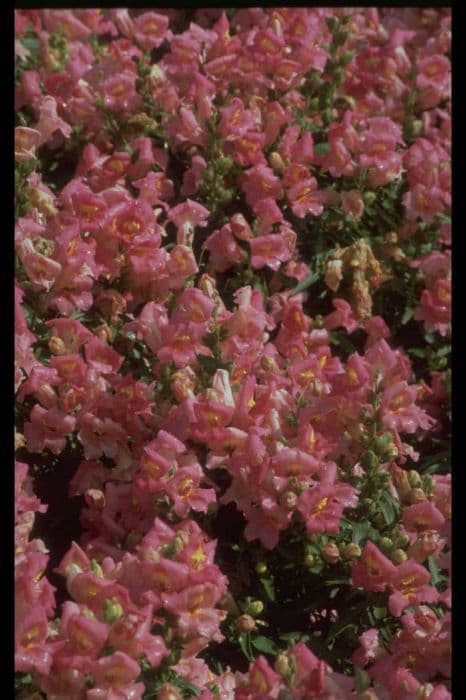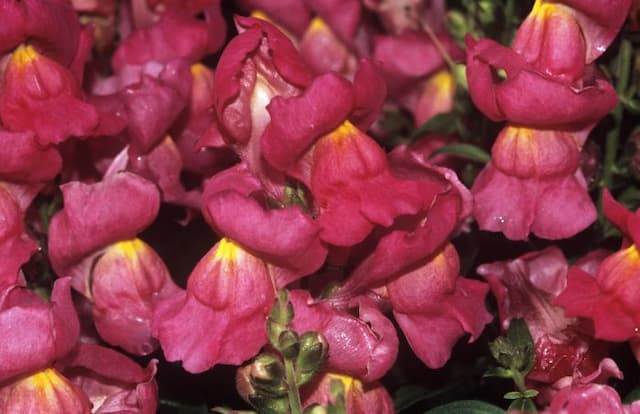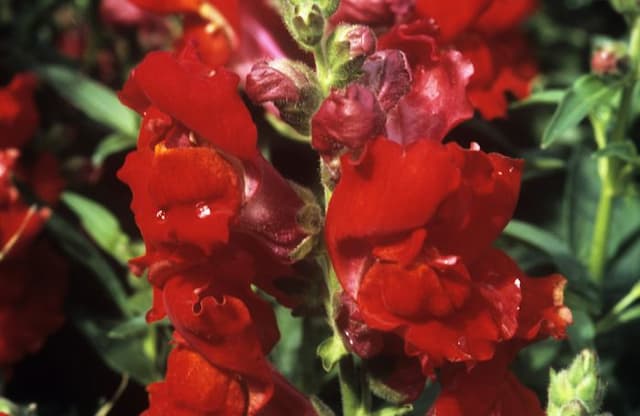Moroccan Toadflax Linaria maroccana

ABOUT
Linaria maroccana, commonly known as Moroccan toadflax, is a captivating plant with a vibrant and delicate appearance. It has slender, upright stems that are adorned with narrow, lance-shaped leaves. These leaves are typically arranged in a dense, whorled pattern, contributing to the plant's fine-textured look. The most striking feature of Moroccan toadflax is its colorful flowers. They are small, snapdragon-like blooms that come in a variety of colors, including shades of pink, yellow, purple, orange, and white, often with a contrasting palate of colors in the throat or center of the flowers. The blossoms grow in racemes or spikes, which means they are arranged along the stem, giving the plant a tapered floral display at the tip. The overall allure of Moroccan toadflax is enhanced by its delicate and finely-spaced blooms. They have a spur at the back, which is a common characteristic among flowers in its family. The plants often create a spectacular show when planted in masses, weaving a tapestry of color that can transform a garden space. Despite its dainty appearance, Moroccan toadflax is known for its resilience and ability to thrive in a range of conditions, making it a popular choice for gardeners looking to add long-lasting color to their floral arrangements.
About this plant
 Names
NamesFamily
Plantaginaceae
Synonyms
Moroccan Toadflax, Spurred Snapdragon, Baby Snapdragon
Common names
Antirrhinum maroccanum, Linaria bipartita, Linaria elatine.
 Toxicity
ToxicityTo humans
Baby Snapdragon, commonly known as Linaria maroccana, is not typically known for its toxicity to humans. There is no widespread evidence to suggest that this plant poses a significant health risk if touched or ingested in small quantities. However, it is always possible that individuals could experience mild stomach upset or an allergic reaction if they ingest parts of the plant or handle it and then touch their mouth or eyes. If large amounts were consumed, more severe gastrointestinal distress could potentially occur, although such cases are rare. As with any plant, it is wise to exercise caution and keep it out of reach of small children who might ingest it out of curiosity.
To pets
Baby Snapdragon, commonly known as Linaria maroccana, is generally not considered toxic to pets. It does not appear on lists of poisonous plants for animals such as dogs and cats. However, like with humans, individual animals might have sensitivities that could lead to mild gastrointestinal upset if they ingest parts of the plant. It is always prudent to monitor your pet's behavior and keep an eye on their health if you notice they have ingested any part of a plant. Symptoms of plant toxicity in pets are often similar to those in humans and can include drooling, nausea, vomiting, and diarrhea. If you suspect your pet has ingested a large amount or is showing signs of distress, contact your veterinarian.
 Characteristics
CharacteristicsLife cycle
Annuals
Foliage type
Deciduous
Color of leaves
Green
Flower color
Varies
Height
1-2 feet (30-60 cm)
Spread
0.5-1 feet (15-30 cm)
Plant type
Herb
Hardiness zones
2-9
Native area
Morocco
Benefits
 General Benefits
General Benefits- Easy to grow - Linaria maroccana, commonly known as Moroccan Toadflax, is adaptable to most soils and requires minimal care.
- Attracts pollinators - The colorful blooms attract butterflies and bees, aiding pollination in the garden.
- Aesthetic appeal - Moroccan Toadflax adds a splash of color to garden beds, borders, and containers with its vibrant flowers.
- Quick blooming - It has a fast growth cycle and produces flowers quickly, ideal for adding timely color to gardens.
- Drought tolerance - Once established, it is relatively drought-tolerant, making it suitable for xeriscaping or low-water landscapes.
- Edging plant - Due to its compact size, it is perfect for edges, pathways, or as a ground cover to define garden spaces.
- Deer resistant - Moroccan Toadflax is not a preferred food source for deer, so it often remains undisturbed in areas with deer populations.
- Self-seeding - It can self-seed under the right conditions, providing an effortless way to propagate and sustain the garden's display year after year.
- Variety in color - Comes in a range of colors, which allows for personalized color schemes in garden design.
- Cut flower - The blooms make for charming cut flowers in bouquets due to their delicate appearance and variety of colors.
 Medical Properties
Medical PropertiesThis plant is not used for medical purposes.
 Air-purifying Qualities
Air-purifying QualitiesThis plant is not specifically known for air purifying qualities.
 Other Uses
Other Uses- Linaria maroccana, commonly known as Moroccan toadflax, can be used as a natural dye for fabrics, providing various shades of yellow depending on the mordant used.
- The stems and leaves of Moroccan toadflax may serve as a mild insect repellent when crushed and applied to the skin or placed around outdoor living spaces.
- Dried Moroccan toadflax flowers can be incorporated into potpourris to add fragrance and color to a room.
- In craft projects, the colorful blooms of Moroccan toadflax can be pressed and used for decorative purposes in scrapbooking or card making.
- The plant can be employed as a temporary ground cover to stabilize soil in areas where permanent landscaping is being planned.
- Moroccan toadflax can be grown in containers and hanging baskets to add a cascading effect with its slender stems and colorful flowers.
- When planted in a vegetable garden, Moroccan toadflax may help in attracting pollinators, thus increasing the yield of vegetables.
- The seeds of Moroccan toadflax can be used for educational purposes, demonstrating plant life cycles and seed germination processes to students.
- Gardeners may use Moroccan toadflax as a living row marker in their gardens to delineate between different plantings.
- Photographers and artists may find inspiration in the vibrant colors and delicate structure of Moroccan toadflax for their works.
Interesting Facts
 Feng Shui
Feng ShuiThe Moroccan toadflax is not used in Feng Shui practice.
 Zodiac Sign Compitability
Zodiac Sign CompitabilityThe Moroccan toadflax is not used in astrology practice.
 Plant Symbolism
Plant Symbolism- Resilience: Due to its ability to grow in harsh conditions, Linaria maroccana, commonly known as Moroccan toadflax, often symbolizes resilience and the capacity to endure challenging circumstances.
- Humility: As a small and unassuming flower, Moroccan toadflax can represent humility, urging us to remember the beauty of simplicity and modesty.
- Grace: With its delicate appearance, Moroccan toadflax is sometimes associated with grace and elegance, showcasing how even the smallest of plants can have a gentle, refined beauty.
- Adaptability: Moroccan toadflax's ability to thrive in various environments makes it a symbol of adaptability and the versatility to adjust to different life situations.
- Prosperity: The prolific nature of Moroccan toadflax, which can cover fields with its vibrant hues, sometimes makes it an emblem of prosperity and abundance.
 Water
WaterTo keep your Moroccan Toadflax healthy, water it deeply but infrequently, allowing the soil to dry out slightly between waterings. This could generally mean watering about once a week, but this can vary depending on climate and soil conditions. A good approach is to provide about 1-2 gallons of water per plant per watering session, ensuring that the water penetrates the soil to reach the roots without causing waterlogging. Overwatering can lead to root rot, so it's essential to avoid letting the plant sit in soggy soil. During the peak growing season, keep a closer eye on the moisture level of the soil, as the plant may require more frequent watering.
 Light
LightMoroccan Toadflax thrives in full sunlight, so position it in a spot where it can receive at least six hours of direct sun daily. These plants can tolerate partial shade, but they will bloom most prolifically with ample sunlight. Avoid placing them in deep shade, which can lead to weak growth and fewer flowers. The best spot for this plant is in an area that gets uninterrupted sunlight throughout the day, such as a south or west-facing location.
 Temperature
TemperatureFor Moroccan Toadflax, the ideal temperature range is between 50°F and 75°F. They can withstand minimum temperatures down to 40°F and maximum temperatures up to around 85°F without distress. However, prolonged exposure to temperatures outside this range can harm the plant. Plant Moroccan Toadflax in an area that avoids extreme temperature fluctuations for best growth.
 Pruning
PruningMoroccan Toadflax benefits from occasional pruning to encourage bushier growth and more blooms. Prune or deadhead spent flowers regularly to stimulate new flower production. The best time for a more substantial pruning is in the late winter or early spring before new growth begins. Pruning every few weeks to remove old flowers can keep your plant looking tidy and may extend the blooming period.
 Cleaning
CleaningAs needed
 Soil
SoilFor Moroccan Toadflax (Linaria maroccana), the best soil mix is light, well-draining, and relatively poor, as too rich soil can discourage blooming. A mix of loamy or sandy soil amended with perlite or sand works well. The ideal soil pH should be slightly acidic to neutral (pH 6.0 to 7.0).
 Repotting
RepottingMoroccan Toadflax does not typically require frequent repotting, as it is often grown as an annual. If grown as a perennial, repot every 2-3 years or when it appears to be root-bound.
 Humidity & Misting
Humidity & MistingMoroccan Toadflax prefers average ambient humidity and does not require any special humidity conditions to thrive.
 Suitable locations
Suitable locationsIndoor
Place Moroccan Toadflax in bright light and well-draining soil indoors.
Outdoor
Plant Moroccan Toadflax in full sun and well-drained soil outdoors.
Hardiness zone
2-9 USDA
 Life cycle
Life cycleMoroccan Toadflax (Linaria maroccana) begins its life as a seed, which germinates in favorable conditions of adequate moisture and temperature. As the seedling emerges, it grows into a small plant with lance-shaped leaves, developing a root system to absorb water and nutrients. The plant then enters a vegetative stage, where it grows rapidly and produces more leaves, preparing for reproduction. As it matures, Moroccan Toadflax produces colorful flowers, typically in shades of purple, yellow, or white, which facilitate pollination by attracting pollinators such as bees and butterflies. Following successful pollination, the flowers develop into fruit capsules containing seeds which, when mature, are released into the environment to begin a new generation. The plant may complete its life cycle within one growing season, behaving as an annual, though some individuals may persist for multiple seasons in appropriate climates.
 Propogation
PropogationPropogation time
Spring-Summer
Propogation: Toadflax, or Linaria maroccana, is commonly propagated by seed. The best time for sowing toadflax seeds directly is in the spring, after the last frost when soil temperatures have warmed sufficiently. The seeds should be lightly covered with soil since they require some light for germination and typically sprout within 14 to 21 days. These seeds may also be started indoors 6 to 8 weeks before the last expected frost, planting them in seed starting mix and transplanting the seedlings after the danger of frost has passed. For optimal growth, it is important to space the plants 6 to 8 inches (about 15 to 20 centimeters) apart to allow them enough room to mature.









